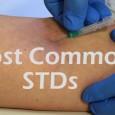Condoms are supposed to act as a protective barrier against the contraction of sexually transmitted diseases during sexual contact. However, there are some STDs that can be contracted even with the use of protection, typically via direct or indirect contact through the skin.
Since condoms primarily act to bar STDs carried through bodily fluids such as in semen, vaginal fluids, and blood, STDs that are viral and occur through the skin are prone to spread even with condom use.
This includes human papillomavirus, genital herpes, syphilis, crabs/public lice, and molluscum contagiosum. STDs under this breadth can be transmitted through skin to skin contact, which means wearing a condom does not guarantee protection.
Disclaimer: condom-sizes.org is supported by its readers. When you buy through links on our site, we may earn an affiliate commission. Learn more.
It’s widely known condoms are not 100% safe and guaranteed, even for the easily preventable STDs. If used properly, however, they can greatly reduce the risk of contracting a sexually transmitted disease. Even so, the most surefire way to protect yourself is to abstain from sexual activity if you or your partner has an STD.
Despite this, some infected people are unaware they have an STD because symptoms can be unrecognizable. Being aware of how these STDs are spread can help prevent transmissions.
1. HPV (human papillomavirus)
HPV is the most commonly contracted STD and is prevalent in over 100 strains of the virus. Symptoms of HPV can go relatively unnoticed, while others can exhibit skin or mucous membrane growths on their body, otherwise known as warts. HPV is typically spread through skin to skin contact with the infected genital skin, warts, or bodily fluids, which means condoms can be essentially ineffective in protecting your body from this disease.
Since some strains of HPV show no signs of symptoms, many people don’t actually realize they are infected and can pass on the strain to their partners.
You can get HPV through both vaginal and oral sex, and even pass it on through skin contact uncovered by a condom. Most of the time, HPV will dissipate on its own without causing any major health problems.
However, HPV that stays present can cause genital warts and even cervical cancer in women. While HPV is common, and protecting yourself against it can be tricky, there is a vaccination that can protect both males and females against the HPV disease.
Routine screening for cervical cancer is also recommended for women.
2. Genital herpes
Genital herpes is another commonly contracted viral sexually transmitted disease. Genital herpes can be caused by two types of viruses called herpes simplex type 1 and herpes simplex type 2, and can be spread through vaginal, oral, or anal sex with an infected partner.
The lesions or sores commonly associated with this STD can occur on any part of the genital region typically uncovered by a condom, and can be spread through skin to skin contact.
You can even contract the disease from an infected partner who does not display any visible signs of the virus. Even if someone does not have any sores, the virus can still be released through the skin and spread to the opposite partner.
Wearing a condom can definitely reduce the risk of contracting the virus, but it serves as no help if the infected person transmits it through skin to skin contact in other areas of the genital region.
3. Syphilis
Syphilis is another highly contagious sexually transmitted infection spread through oral, vaginal, and anal sex. Syphilis is typically spread through direct contact with an infected person’s syphilis sore during sexual activity, which can be found on the penis, vagina, anus, rectum and even on the lips and mouth.
Syphilis can also be spread from an infected mother to an unborn baby. Therefore, syphilis can be contracted from skin to skin contact regardless of the use of a condom.
Syphilis can have many symptoms, some of which include a painless syphilis sore as well as an itchy body rash that can develop during the second stage of the disease. Condoms can prevent transmission of syphilis if the sores are strictly limited to a site covered by condoms, although it is still not completely guaranteed. Contact with sores not covered by condoms can transmit the disease.
4. Crabs/pubic lice
Pubic lice, commonly called crabs, are tiny insects found in the genital area that can be spread through sexual contact and are not protected against by condoms. It is also possible to catch pubic lice through sharing clothing, bed linens, or towels with a person infected. Since pubic lice feed on blood, their bites can cause severe itching and can be an indication of infection.
Itching in the genital area and visible lice eggs are common signs of crabs. They can live among pubic hair and can be spread via any kind of direct contact. Pubic lice are typically treated via a lice-killing lotion that is available over-the-counter with a prescription.
5. Molluscum contagiosum
Molluscum contagiosum is a viral infection caused by a poxvirus, and emerges as a benign, mild skin disease accompanied by lesions on the body. These lesions are typically small and raised, with a white, pink, or flesh color. They may become itchy, sore, red and swollen. These can occur anywhere on the body, including the face, neck, arms, legs, and abdomen.
This virus is easily spread from person to person through skin contact or sharing towels and clothing, and so cannot be protected by condom use.
Molluscum contagiosum in the genital area is considered a sexually transmitted infection. The lesions associated with the virus usually disappear on their own, although continuously developing bumps may appear for up to five years.
Despite this, once the lesions have disappeared, you are no longer contagious. Doctors may recommend that the lesions be removed, especially in adults, because of their level of contagiousness.





